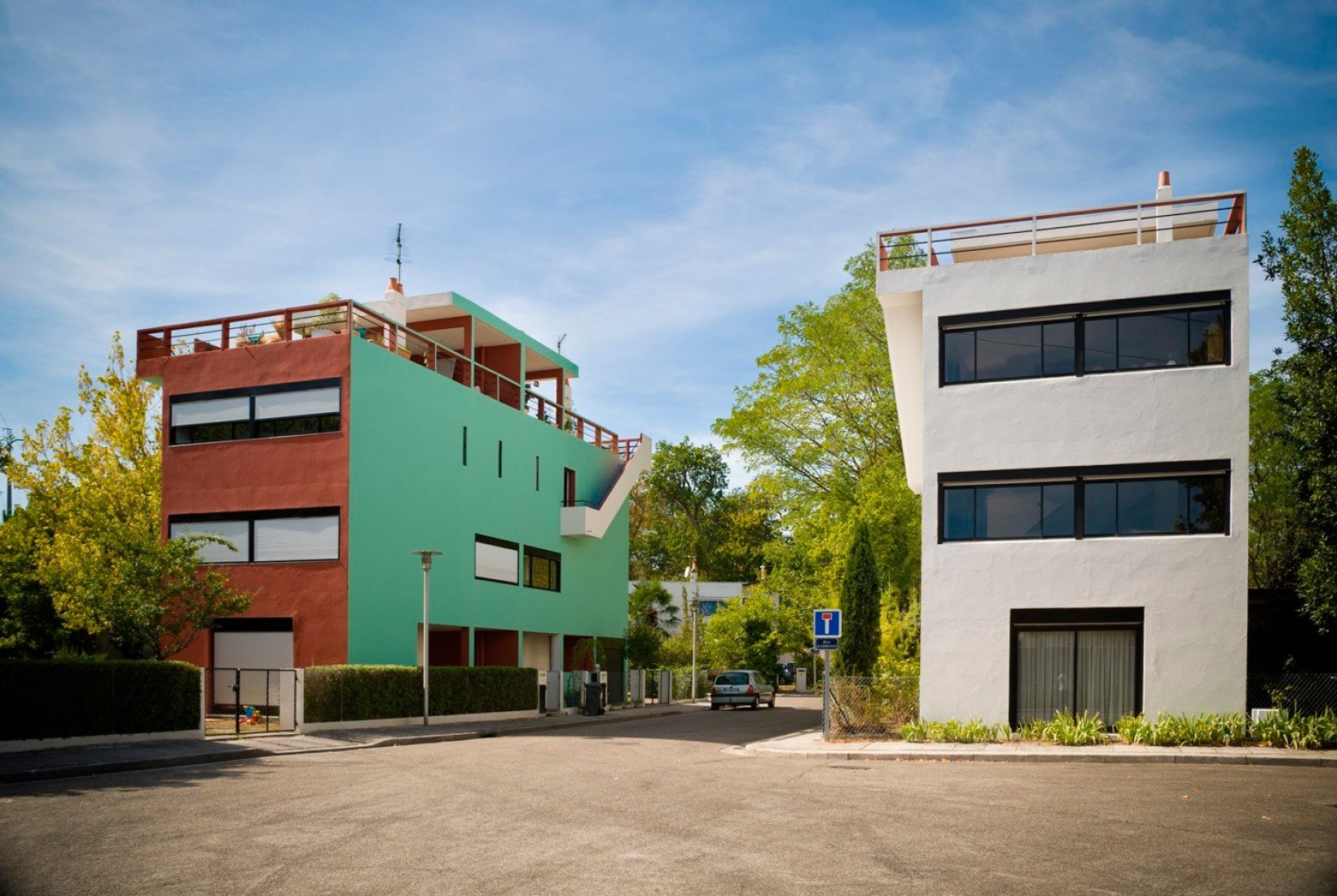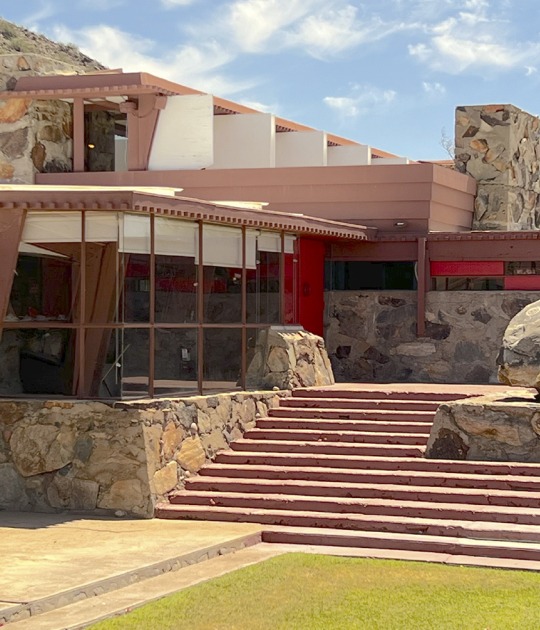La Cité Frugès, classified together with 16 other architectural works of Le Corbusier, World Heritage Site in 2016, was built between 1923 and 1924 along with two experimental houses on the Atlantic coast in Lège, also commissioned by Frugès. At the same time as Le Corbusier was with the construction of these projects, he developed other buildings of great importance, such as the Ozenfant studio and the Villa Venus in Vaucresson in 1992, Maison La Roche-Jeanneret in 1923 and the Pavilion L'Esprit Nouveau In 1925.
As a consequence of the publications made by Le Corbusier during the years 1920 to 1923 in "Vers une Architecture", where he defended economic social housing while referring to housing as living machines and expounding his ideas on standardization and production, Henry Frugès, an industrialist interested in architectural and artistic innovations, decided to entrust the project of the Cité to Le Corbusier and Pierre Jeanneret. "I authorize you to carry out your theories to practice ... and I want to achieve really conclusive results in the reform of cheap housing: Pessac must be a laboratory."
The place chosen for the project, responded to a series of important requirements for the promoter. First of all the site was completely surrounded by a forest where it had not been built previously. The second requirement was that it was close to the industries where the habitants of the neighborhood were going to work as well as it was located near the train tracks, a sign of modernity. Finally, given the frequency of tuberculosis among the workers at that time, the project location was chosen near a tuberculosis hospital.
Although he had already begun to develop the five points of architecture in his projects, it is in La Cité Frugès that Le Corbusier performs for the first time "the horizontal garden city", his idea of a utopian city. One of the main ideas of the project was to carry out a standardized model of "low-cost" housing that claimed to be economical and quickly built. This would become the principle of the redefinition of man, society and art.
Another of the main concepts that Le Corbusier carried out in the project of La Cité Frugè was polychromy. He experimented with color in these houses, using three colors (green, red and blue) in order to use the psychological power to suppress the sensation of mass and amplify the sensation of areas and planes.
The lack of experience in the used construction techniques, caused the works to be delayed, preventing the construction of the project in its entirety, projecting only two of the sectors originally devised. As a consequence, of 135 houses initially planned, only 53 could be built, all of them planned with a land where they could create their orchards and gardens. Of the 53, today only 50 are preserved, since three were destroyed during the Second World War.
The standardization of housing is one of the main concepts in the project. Base cellular replication is used; taking as a reference a module of about 5m x 5m, plus a half module that is repeated to achieve the different combinations. This gave rise to a total of six housing typologies: Zig-Zag, Quinconces [Damero], Jumelle [Twin], Gratte -Ciel [Skyscraper], Arcade and Isolée. Among these models we can find blocks containing one to six cells. All homes share a number of features such as terraces and patios, modulated windows or the provision of a space for the car, the idea of the machine is always present.
Of the six combinations created for the project, there are four representative typologies built:
- "Arcade" or arcade: The house extends on the horizon creating a lobby and a terrace that is covered by the arcade and delimited by low walls that will allow privacy. The arcade is born from the roof, covering two levels of the house and allowing a covered view towards the forest, from the room. All this will create in the facade a rhythm of arcs and volumes outstanding in the set. The house locates on the ground floor a living room, kitchen, a bathroom, a single room and a covered terrace; on the first floor there are three medium sized rooms and a roof under the arcade.
- "Isolèe" or isolated (Vrinat): This last dwelling rises on the pilotis, keeping the ground floor free except in the middle center module where the service room will be located with its bathroom. To access the house you need to go up a stair to a small terrace where the lobby-hall is located. If one continues ascending these external stairs, you will arrive at the rooftop where you will find a covered space and a free area terrace. This house will be formed by a first floor with a living-dining room, a kitchen, a bathroom and two medium sized bedrooms.
The main structure of the houses is based on the five points of the architecture, so the cells with a structure of formwork piles, allow different combinations and generate a uniform structure, creating a base of cell + half cell + a cell. The main material used in the project will be concrete, using reinforced concrete in the structure from the foundation. The "arcade" dwellings were the beginnings of Le Corbusier in the experimentation with concrete shells, as well as the use of rails, low walls, shelves and concrete objects adapted to the dwelling.
Description of the project by Le Corbusier
M. Frugès told us: "I authorize you to carry out your theories in practice, even with their most extreme consequences, and I wish to achieve really conclusive results in the reform of cheap housing: Pessac must be a laboratory. I fully authorize you to break with all conventions and to abandon the traditional methods. In a word, I ask you to pose the problem of the house plan, to find its standardization, to use walls, floors, conforming roofs to the strictest solidity and efficiency, lending themselves to a real taylorization by the use of the machines that I authorize you to buy.You will provide these houses with interior equipment and devices that will make the house easy and pleasant. As for the aesthetics, that can be the result of your innovations, will no longer be the one of the traditional houses, expensive to build and expensive to maintain, but of the contemporary era. The purity of proportions will be its true eloquence. "
Pessac is a bit of a Balzacian novel. A generous man wants to show his country that the issue of housing can be resolved. Opinion shifts; the jealousies awake; building corporations, from the local small entrepreneur to the architects, are worried about the new methods that could upset the situation they have acquired. Then, little by little, an atmosphere of hostility is created. The village of Pessac was built in less than a year by a Parisian company that replaced the failing local teams. But in 1926, at the end of the works, a deaf opposition was born in the administrative departments which had to transfer the files of the acceptance of the road and consequently to order the installation of the water in the village. So, only the authorization to lease or sell could be granted.
Three years later, in the spring of 1929, the files were not signed and for three years the village was empty of habitants. However, two ministers took care of it personally and came to visit Pessac officially. M. de Monzie, Minister of Public Works, in 1926; M. Loucheur, Minister of Labor in 1929. The enthusiasm which followed the official ministerial visit gradually succeeded the anxiety and, after three years, the press in several countries wrote that Pessac was uninhabitable because it was built on erroneous principles. Finally, thanks to Mr. Loucheur's energetic intervention, an investigator went back to the origin of this troubling adventure and finally found the causes of the lack of water. This is a painful and severe lesson to be categorized in the annals of the idea, and shows that the new initiatives clash with public opinion, and that opinion is waging war on ideas.
Pessac is designed because of the reinforced concrete. M. Frugès, the self-sufficient industrialist of Bordeaux, had said: "I would like to allow you to apply your theories."
The goal: the cheap.
The means: the reinforced concrete.
The method: standardization, industrialization, taylorization.
Structure: A single reinforced concrete beam (Pima floor) of 5 meters, for the entire housing development, etc. etc. Team Division: Each team performs the same job.
This is an example of modern urbanization, where the historical memories, the Swiss chalet or the Alsatian dovecote were left in the museum of the past. A mind devoid of romantic impediments, seeks to solve a well-posed problem.
Polychrome. An illustrious esthete, returning from Pessac, said: "A house is white."
We gave the standard of appreciation: white facades.
When house lines created an opaque mass, we camouflaged each house: the facades on the street alternately brown and white.
A white lateral facade, the other pale green. The encounter on the ridge, light green or white, with dark brown causes the volume suppression (weight) and amplifies the spreading of the surfaces (extension).
This polychromy is absolutely new. It is basically rational. It brings to the architectural symphony, elements of extreme physiological power.
The concerted conduct of physiological sensations of volume, surfaces, contours and colors can lead to intense lyricism.
The building plot of Pessac is very tight. The gray cement houses made an unbearable compressed clump, without air.
Color could bring us space. Consider the color, as a carrier of space. Here is how we have established fixed points: certain facades painted in pure burnt sienna. We have fled from the line of houses: ultramarine blue.
We have confused certain areas with the foliage of the gardens and the forest: pale green facades.
Extract from Le Corbusier, Complete work, volume 1, 1910-1929













































![10 Architecture Studios Led by women [XII] 10 Architecture Studios Led by women [XII]](/sites/default/files/styles/mopis_home_news_category_slider_desktop/public/2025-03/metalocus_10-arquitectas-xi_01b.jpg?h=3b4e7bc7&itok=KFjWtS5J)









